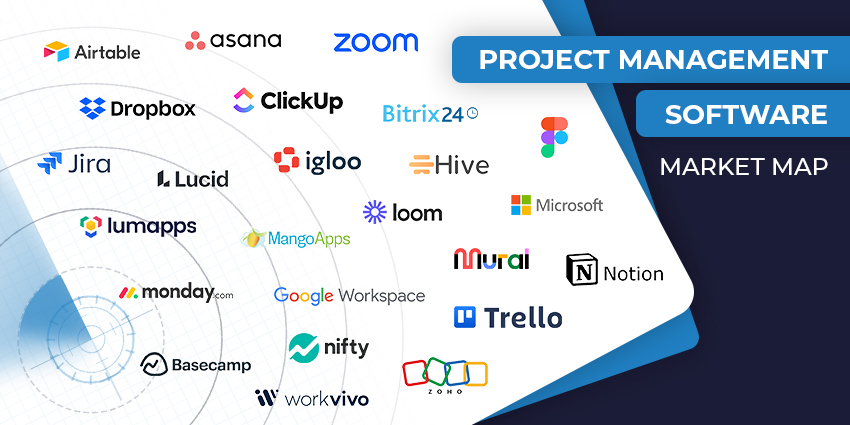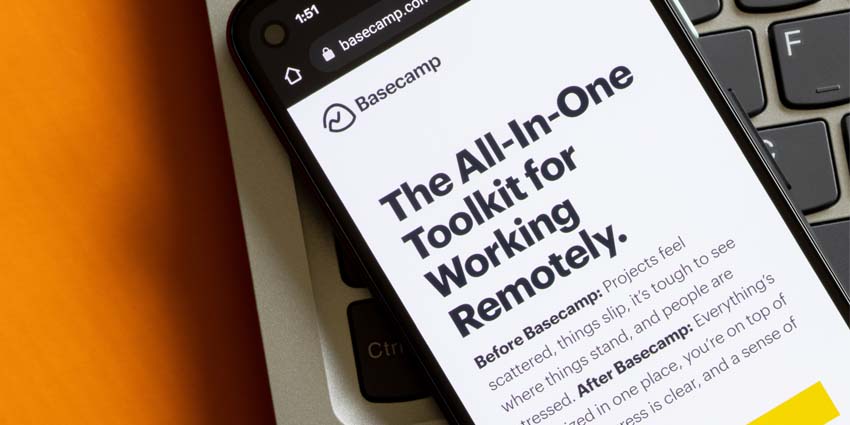Project management tools used to be simple – basic solutions filled with checklists, deadlines, and the occasional chart. Now, the best project management software is a lot more advanced. Most come with multiple view options, integrations for collaboration apps, native shared docs, and even AI.
On one hand, that’s a good thing – more sophisticated tools usually means more productive, better aligned teams, even in the age of hybrid work. But it also means that choosing the right project management system for your employees is a lot more complicated.
Just finding the option with the most features for the lowest price tag isn’t enough. You need a system that fits with and improves how your teams already work. That’s why we created this list, based on the vendors in our project management marketplace, to help you find the toolkit tuned to your team.
The Best Project Management Software
The Best Project Management Software in 2025
Bold claims don’t cut it in the enterprise space. You need tools that deliver clarity. You and your teams need to know who’s doing what, when, and why. Plus, you also need speed: no one wants to dig through busywork just to get started. Here are the best project management vendors, transforming team productivity.
Airtable
A well-known provider of enterprise project management software, Airtable gives companies a flexible cloud-based ecosystem where they can manage and optimize team performance. Today, Airtable has evolved beyond database-spreadsheet hybrids. It’s now an AI-native app platform built for enterprise-grade work management.
With Omni, their integrated AI assistant now available, even on free tiers, teams can auto-generate code, build relational workflows, and categorize tasks instantly . For enterprise users, that includes robust automations, two-way sync, audit logs, and HIPAA/SOC 2 compliance
Airtable is mall about scale, with support for tens of thousands of users, the option to choose your own AI models, and flexible administration. Plus, all the standard features you’d expect are built in, from deadline tracking, to project templates.
Asana
Asana ranks as one of the best project management software solutions for countless teams. Straightforward, easy to use, and now packed with intelligence, Asana streamlines everything from creative production to campaign management.
You set the plan, you add the owners, and you map the dependencies. Then the system keeps track of what’s moving and what’s stuck. Nobody gets flooded with notifications, but the right people see the right problems early. There’s a portfolio view for managers. A timeline for planners. Plus enough rules and automations to keep daily stuff off people’s plates.
The AI features are great for summarising updates, flagging blockers and auto-assigning tasks when a form is submitted. Plus, Asana integrates with everything you already use, from Dropbox, to Microsoft Teams, Salesforce, and Figma.
Basecamp
Basecamp aims to be the one place everyone turns to. Messages, to‑dos, files, calendars, chat (they call it “Pings”), and even client access, everything lives under one roof. There’s no configuring boards or automations out of the box. Instead, it gives you just what you need and hides the rest.
The recent Hilltop View update puts all your Hill Charts, those simple uphill/downhill progress visuals, into a single pane. You get instant clarity on what’s in progress, and what’s still being planned. Plus, there are improved templates. You can now copy a project structure and manage what clients see in it, without juggling privacy settings.
Time tracking rolled in as an add‑on, so teams billing hours can log time within specific to-dos without external apps. If your teams need notifications to flow somewhere else, or if you want chat in the mix without email clutter, Pings and the “Hey!” notification center serve that purpose neatly.
Bitrix24
Bitrix24 is an all-in-one workplace for managing and supporting teams. The flexible ecosystem combines a CRM with collaboration tools for video conferencing, chat, task and project management, and HR automation. Bitrix24 integrates with hundreds of online services and apps and features its own AI-powered assistant, which can be adapted with an AI model of your choice.
On the project side, it gives you your basics: Kanban, Gantt, task timers. But it also lets you dig deeper with roles (like participants, observers), workload management, and task scheduling. BI dashboards just got better too, you can now give groups view/edit rights in bulk, not item by item.
The company’s robust toolkit promises ease of use while giving businesses access to critical tools for sales, marketing, and customer service teams. There are lead acquisition and management features, work reports, cloud storage solutions, all built-in.
ClickUp
One of the best project management software solutions for teams in search of simplicity, ClickUp streamlines both task and team management. It gives you every view imaginable: list, board, Gantt, calendar, and adds docs, goals, chat, whiteboards, and more. You can build custom statuses and automations around them until it matches your enterprise needs.
Today, ClickUp is packed with useful AI. There are tools that can generate project plans, handle status updates, assign tasks, and automatically move things along the pipeline. The automations are powerful. You can say “when a task moves to review, assign to Sally, set due date three days out, and ping the Slack channel.”
ClickUp’s technology features built-in collaboration options too, including options for creating video clips and annotating documents in real time. Plus, you can design dedicated digital spaces for specific teams with custom roles and permissions.
Dropbox
Best known for its cloud storage solution, Dropbox can also act as a company’s enterprise project management software. The “Dropbox Paper” technology allows organizations to create project management task lists and to-do lists, set deadlines, and assign specific actions to different team members. There are even templates you can use to help align your teams.
Dropbox Paper can send automatic reminders to contributors in your workplace when deadlines are approaching, and it includes collaboration features. Teams can work on projects in real time and @mention other staff members responsible for specific tasks. The solution also integrates with various leading collaboration apps.
Dropbox Dash also makes it easier to find crucial information. It digs through not just docs, but videos and images, even highlighting who’s working on what.
FigJam
FigJam is whiteboarding without the whiteboard. It gives your team room to innovate with stickies, arrows, votes, all in a shared digital space. You can use it for stand-ups, brainstorms, retros, or anything else. When someone needs to sketch fast and iterate together, this is where they land.
It doesn’t seem like some of the other best project management software solutions we’ve mentioned at first glance. But it can definitely make workflows simpler. Draw a simple Kanban board, assign sticky notes to people, drop timers on icebreakers. Next thing you know, you’re capturing scope and action items mid-brainstorm, without switching tabs.
Templates, from retrospective frames to sprint planning setups, turn thinking sessions into actionable follow-up without manual cleanup . If you’re already in Figma for design, having FigJam built-in is a bonus for visual alignment and design handoffs.
Google Workspace
Google Workspace is an all-in-one portfolio of business apps and collaborative tools created to connect teams of all sizes. The solution comes with access to features like Gmail, Google Docs, Google Sheets, and more, all of which can help businesses to align their teams and manage projects. Plus, the system can integrate with other project management apps.
With Workspace, you can start a shared doc, sketch a plan in Sheets, drop action items into Tasks, tag people in comments, ping reminders in Chat, and meet about the updates in Meet. Gemini is a big part of the experience now too.
The AI toolkit can help you organize project data, track budgets, create action items, assign tasks, and collect insights. There’s also Gemini in Slides to create custom visuals based on prompts, and Gemini in Meet for intelligent note-taking.
Hive
Hive is one of the best project management software solutions for busy teams. It looks simple at first, but gives you plenty of features, from tasks, forms, and chat tools, to project overviews, built-in custom reminders, and data analysis.
You can set a task, nudge people automatically if things stretch, and see what’s stalled right on the project screen. Plus, their forms feature keeps intake neat, whether it’s a budget request or new design brief, channeling work straight into your plan.
Hive’s appeal is in balance. You get structure, but not inflexibility. It’s easy to drag tasks from board to calendar, shift owners, and see real-time updates from your team. And if you need deeper coordination, Hive hooks into Slack, Zoom, Google Workspace, MS 365, and evergreen platforms like Jira.
Igloo Software
Designed as an intranet for the digital workplace, Igloo brings workforces together in a virtual environment where they can share ideas and content. The all-in-one platform includes capabilities for knowledge management, communication, employee engagement, and gamification. Plus, there are a range of flexible tools for project management, such as to-do lists and templates.
Like most of the best project management software providers, Igloo is experimenting with AI, bringing it into tools for document search, knowledge management, and employee communication. The system also offers solutions to help businesses improve company culture, track employee engagement, and keep frontline teams connected.
In the spring rollout, they sharpened the page-editing experience, added stronger templates, and cleaned up their permissions UI. Now it’s easier to set guidelines for who sees what, and get consistently styled project pages without starting from scratch.
Jira
Produced by Atlassian, Jira is an enterprise project management software solution, delivered through the cloud. The technology is intended to support any agile team, with scrum and kanban options, comprehensive roadmaps, and reports. You can use Jira for everything from sprint planning and version management to time tracking.
You set up a board, define your backlog, and Jira’s filters, statuses, and sprints do the lifting. What most folks miss is how well Jira logs progress: transitions, comments, attachments, velocity. Every bit of work becomes traceable, which appeals to teams working in regulated or audit-heavy spaces.
Combine it with Confluence and you get documentation, specs, meeting notes, and the work itself in sync. Add bitbucket or GitHub and your issues link directly to code changes.
Loom
Loom takes a different approach to empowering businesses than most enterprise project management tools. The company focuses on aligning staff members with a system for quickly recording and sharing AI-powered videos and messages. The platform offers a screen recorder system, as well as comprehensive features for editing and personalizing content.
It’s not trying to replace your meetings or your docs. It’s filling the space in between. Walk through a deck. Show a bug. Leave feedback on a design file. Say what you need to say, click send, and get back to whatever you were doing.
Plus, with Loom, users have the option to share or embed videos anywhere, including in Slack and Google Workspace. Loom’s technology includes enterprise-grade security with custom video privacy controls. Moreover, users can take advantage of transcriptions, closed captions, custom backgrounds, and video or viewer insights.
Lucid
Lucid is where you go when you don’t know where to start. You’ve got a plan in your head, or maybe just a problem that no one can quite explain. So you drag a few shapes on a canvas and see what it looks like when you lay it out. The Lucid visual collaboration suite makes it easy to connect and share ideas throughout creative projects.
You can diagram a process, build a map, sketch a plan. It all feels fast and collaborative. And when you’re ready, you can take that board and plug the next steps into Jira or Trello. Business leaders can track cross-functional projects, and run reports. Team members can also create in-depth diagrams with LucidChart, taking advantage of AI and automation.
Lucid also has its own dedicated whiteboard tool with LucidSpark, which is perfect for brainstorming, strategic visioning, and agile development.
LumApps
Producing solutions for the digital workspace, LumApps is an intranet company with a platform that offers companies a range of easy-to-use tools. Users can take advantage of video-enabled upskilling solutions, customizable task and journey management, and content management tools.
LumApps is built for communication during internal launches, process changes, org-wide updates. The kind of work that’s too big for a Slack message and too easy to ignore in an email. You drop it into LumApps and now it lives somewhere people actually check.
AI, of course, is built in too, whether you’re looking for intelligent search, personalized content creation, or workflow advice. Plus, it all integrates easily with popular business apps, like Microsoft 365 and Google Workspace.
MangoApps
MangoApps describes itself as the ultimate employee experience platform. Aside from offering companies access to enterprise project management software, MangoApps also provides tools for employee surveys, internal communications, and staff wellbeing.
There are task lists, deadlines, reminders, just like you’d get from most of the best project management software. You can track work, and when an urgent update drops, you can @mention a department or message across projects instantly. Companies can also take advantage of specific add-ons, like generative AI assistants, office task management systems, and a dedicated ideal management apps for business creativity.
Under the hood, it’s ready for enterprise: it supports SSO, audit logs, compliance standards, and a few degrees of permissions control. Deployment is straightforward, too, teams that care about communications and collaboration wind up here.
Microsoft
Microsoft’s comprehensive range of business tools encompass everything from collaboration apps like Microsoft Teams to office software. Microsoft Project is the company’s enterprise project management software solution, equipped with multiple project view options (board, grid, Gantt, and more). It integrates with Microsoft Teams, offers co-authoring capabilities, and includes tools for project planning, scheduling, and reporting.
Microsoft Project allows companies to build interactive roadmaps for projects, track resource management, and even access demand management capabilities. Plus, it can integrate with Microsoft’s Copilot solution. This generative AI solution helps companies assess potential risks, receive intelligent suggestions, and monitor issues with projects.
With Microsoft Copilot Studio, organizations also have the option to build custom AI assistants to help with specific project workflows.
Monday.com
Offering both CRM solutions and enterprise project management tools, the Monday.com platform is built for flexible teams. This solution allows companies to plan projects using easily customizable templates and Gannt charts, assign tasks to employees, set due dates, and more. The versatile platform gives companies complete control over their data and a customizable range of reports and dashboards for monitoring metrics.
Monday’s edge is how visually it represents work: color-coded, drag-and-drop, and clear. Admins can dial it down or cranking it up. Automation rules let you say things like “when status hits Done, notify someone.” It connects to Zoom, Slack, Jira, GitHub and anything else your team might use easily too.
Monday.com’s AI features are fantastic too, with intelligent search, and flexible assistants baked into most aspects of the platform. The AI can even assign tasks to team members based on their skill set, availability, and department.
Mural
Mural is a visual collaboration and work platform, built for teams. It allows companies to create project timelines and workflows, and align distributed teams in one environment. The system comes with templates for generating and organizing ideas, planning projects, and even mapping customer journeys. You’ll also gain access to generative AI through a Microsoft Copilot integration.
Copilot for Mural is an intelligent assistant, providing guidance on which tasks can be automated and summarizing essential data in seconds. Mural integrates with various business productivity tools and features a vast selection of meeting outlines, resizable canvas options, and integrated data security solutions.
There are also timers, voting features, lock-down options, and nicer facilitation tools than most virtual whiteboards. Plus, the enterprise side isn’t an afterthought: single sign-on, workspace admin tools, role-based permissions are all there.
Nifty
Described as a “project management operating system,” Nifty includes various tools for companies to help them set goals, track timelines, and complete projects according to their budget. With Nifty, you can plan comprehensive workflows, automate tasks like lead qualification, and access real-time reports into business progress.
The real magic lies in milestones. You link tasks to phases, and it tracks progress automatically, so your timeline starts moving without someone editing charts. There are automation rules too. Want to assign someone when a bug moves to QA? Done it yourself, without any IT help .
It even has chat and lightweight video built in. That means conversations don’t live in Slack and tasks don’t sneak into separate apps. It’s a quiet, subtle glue between work and words.
Notion
Notion is many things as one of the best project management software providers: note-taker, task manager, wiki, mini-database. It started as a notes tool, but people now use it to run whole teams. You build a page, embed a Kanban board, jot down tasks, and suddenly it’s your entire initiative hub.
It’s the tool you fall into when you like control. You pick how your pages look, how your database works. Want projects broken down by deadlines, status, owner, and priority? You can build that. Want meeting notes that auto-grow into action lists? Easy.
The appeal lies in its flexibility. You won’t find Gantt charts by default. But community-made ones exist, and plenty of teams connect Notion to Slack or Jira via API. It’s not for you if you need heavy structure or enforceable workflows. But if your process is still evolving, Notion bends to fit.
Trello
Trello is simple, and that’s exactly why people still use it. You open a board, see three or four columns: To Do, In Progress, Done, and within minutes your project is mapped out. No setup headache. But it’s not just for small stuff. Trello has smart cards now. You can add automation rules, move cards when due dates approach, assign people when a list changes, and send notifications.
Power-Ups (and now Premium Power-Ups) connect Jira, Slack, Dropbox, and hundreds more. If you need controls, like admin features, workspace roles, activity logs, Trello has them. The Enterprise tier even offers attachment restrictions and SSO.
What stands out is that Trello doesn’t pressure you into building apps or dashboards. Its strength is in clarity. You see the flow. You can adapt it as you go.
Workvivo
Workvivo isn’t a project tool in the traditional sense. It’s more like a company social feed—but work takes place in that feed. You see news posts about new initiatives, action items attached to them, and results shared in real time.
It thrives on alignment and engagement. HR teams love it for internal launches, leadership updates, and celebrating wins. But it also surfaces progress: if someone posts “Q2 roadmap kicked off,” you can tap into what’s being done, who’s involved, and where it stands.
The work-centred feed lets updates live where people already look, not buried in ticket systems. When projects roll out to frontline teams or global offices, it ensures visibility, without adding another tool to the stack. Plus, it all works as a seamless part of the Zoom ecosystem.
Zoho
Responsible for various business software tools, such as CRM and sales technology, Zoho also produces project management software for teams. The Zoho Projects platform gives companies a comprehensive dashboard where they can plan projects with calendars, Gantt charts, boards, and more. You can even log employee minutes, for accurate pay management.
There’s built-in chat, document storage, and automated reminders. You can set rules like “when a task is delayed, alert the project manager.” For compliance-heavy teams, there’s audit trails, blueprints, and permission control down to the field level.
Zoho integrates with dozens of enterprise apps, from Dropbox and Jira, to ServiceNow and Office 365. It also includes enterprise-grade security, for peace of mind.
Zoom
Zoom approaches project management in a few different ways. First, you’ve got Workvivo baked in. But you can also take advantage of Zoom Docs for real-time collaboration and knowledge sharing among hybrid teams. Then there’s AI Companion to help with project planning.
Zoom Tasks is particularly appealing, living inside of the chat and meeting environment within Zoom, and creating tasks during and after meetings without endless prompting. The AI solution picks up on context, and knows how to assign action items to the right people, check-in on project progress, and keep business leaders up to date.
Teams working remotely, or who live in Zoom, get a lift from that. No switching tools. No lost items in other apps. It’s simple: assign, remind, move on.
Stay Aligned with the Best Project Management Software
We’ve covered twenty-five different tools here, not to confuse you, but to give a real look at the options. Every team works differently. Some need structure first, others want flexibility. Some live inside whiteboards or file stores. Others stay synced in chat or customer hubs.
Unfortunately, with all of these great options to choose from, it can be tough to make the right decision. That’s why UC Today is here to act as your friendly, professional guide, every step of the way. We’ve created a host of resources to help you take your next step towards a stronger workplace.
Here’s what you can do next:
- Dig deeper into the data: Download our latest reports, created in collaboration with the world’s biggest software leaders, for insights into trends and opportunities.
- https://www.uctoday.com/reports/
- Join the network: Connect with peers who’ve gone through the same challenges, and get tips from industry thought leaders in the UC Community.
- See it live: Attend upcoming events and demos that bring tools to life. Speak to the vendors and put the latest features to the test.
- Plan with confidence: Build out your entire workplace stack, with our comprehensive UC Buyer’s guide, covering everything from hardware to software.
The best project management software won’t automatically repair broken workflows, but it will give you the tools you need to empower, align, and support your teams. If you’re ready to take productivity, efficiency, and creativity to the next level, start here.







